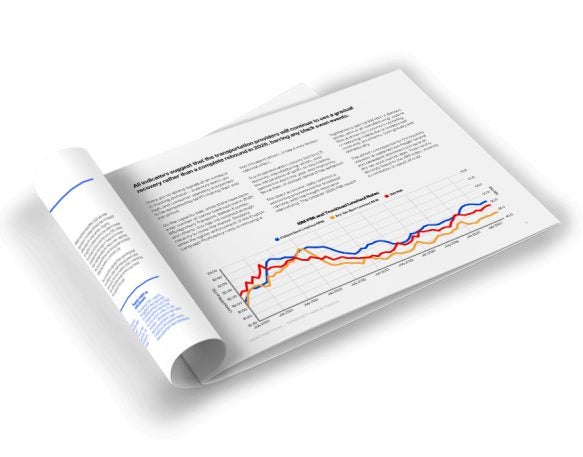
What’s next for freight? How shippers can use data to prepare
The freight industry may seem unpredictable, but beneath the volatility, there are patterns you can track—if you have the right data. An accurate freight market forecast helps you move beyond reacting to market shifts and start making proactive, confident decisions. By anticipating changes in rates, capacity, and demand, you can better align your procurement, budgeting, and network strategies for long-term success.
Freight data, and the value of seeing what’s ahead
The freight market is huge, dynamic, and often unpredictable, but it does have patterns that you can track and take advantage of. With the right data, you can move from reacting to changes and disruptions to taking proactive steps. Anticipating changes in rates, capacity, and demand with high-quality forecasting tools helps you make smarter, more informed logistics decisions.
This article will walk you through why forecasting matters (now more than ever), the main components of a freight market forecast, how you can apply it, and what tools you can use for smarter logistics planning. With a proactive approach, you can better understand the market landscape to apply data-driven insights to procurement, budgeting, and strategy.
Why forecasting matters more than ever in freight
In today’s freight market, shifts in rates, capacity, and demand have become the norm. Seasonal shifts, supply chain disruptions, and macroeconomic policies like tariffs are driving both large-scale and lane-level changes. As these fluctuations become more frequent and exacerbated by extreme weather and global uncertainty, traditional logistics planning methods are no longer flexible enough to keep up.
Forecasting is essential if you want to stay in front of your competitors and have clear insights into your freight outlook. Data-driven approaches help you to make more flexible, accurate decisions. This includes timing your procurement more strategically, controlling costs, and keeping services continuous even during disruptions. Instead of taking a reactive approach to market changes, a good freight market forecast helps you to anticipate and prepare for them.
The building blocks of freight forecasting
Effective freight forecasting is built on three main components: historical trends, real-time market data, and predictive analytics. Each aspect plays a key role in providing you the holistic insights you need to stay ahead of market shifts.
Historical trends
The first key aspect of a good freight forecasting approach is looking at historical trends. By analyzing past data, you can identify recurring seasonal shifts, demand spikes, and market cycles that have an influence on freight rates and capacity. Understanding historical patterns helps you to anticipate future trends, although on its own it is not enough.
Real-time market data
Another important part of freight forecasting is using tools and technology to help you gather real-time market data. Your internal data may not be enough, and is often siloed and fragmented. Additional context and broader market data help you to take advantage of opportunities to optimize spending and secure additional capacity. This real-time data can include current rate changes, load-to-truck ratios, and the shifting of regional imbalances, so you can use up-to-the-minute insights to make better decisions. This data helps you react quickly to market changes, whether it’s a sudden capacity shortage, as well as responding to changing truckload rate predictions in key lanes.
Predictive analytics
Finally, make use of advanced analysis tools and predictive rate analytics solutions. This can help you to make lane-level truckload decisions based on reliable rate forecasts and capacity trends. This information allows you to plan for various scenarios and take proactive action, from managing cost fluctuations to making sure you have carriers available during peak seasons.
How you can apply freight market forecast insights across your operations
Now that you know what types of freight forecasting approaches you can use, let’s take a look at how to actually apply them. Once you have freight market forecast data, the key is knowing how to use it effectively across different areas of your operations. By making use of these insights and applying them well, you can make more informed decisions, save costs, and improve business performance.
- Smarter budgeting and rate planning
First, you can use freight market forecast insights for budgeting and rate planning. Forecasting helps you estimate costs more accurately during bid cycles and budgeting, so you can make proactive choices or take action when truckload rate predictions fluctuate. Forecasting data can help you adjust your budgets and contracts based on projected changes in rate environments. - Proactive procurement strategy
With freight market forecast data, you can proactively adjust your procurement strategy. For example, you can carry out mini-bids when the timing is right. These mini-bids can be useful in situations where you are part way through a contract, or where market conditions have changed significantly. In addition, you can adjust routing guides and rebalance carrier networks based on upcoming trends, so that your operations run smoothly and are not disrupted by seasonal or industry changes. - Carrier strategy and relationship management
Finally, forecasting allows you to set realistic expectations with carriers. When you have data from historical trends, as well as real-time information on capacity and pricing, it’s much easier to set fair rates and expectations. Forecasting data and analytics insights can also be shared with your partners, so that you can carry out collaborative logistics planning. It also helps you to reduce misalignments of expectations or goals, and keeps your partnerships strong.
What makes a freight market forecast useful?
It’s important to make sure your freight market forecasts are actually useful. Forecasting data that can’t help you is a waste of time and resources. To make sure your forecasts provide the most benefit, they should be accurate, transparent, frequent, and actionable. Let’s take a look at each of those in more detail.
Lane-specific accuracy
General or broad-brush forecasts won’t provide the detail necessary to make informed decisions. A helpful freight market forecast should be specific to the lanes you’re operating in and provide insights into rate trends and capacity on a granular level.
Ensure your forecasting tool provides precise lane and regional details and enough information to assess conditions at a glance. If you want a higher-level view, an AI-powered forecasting tool that uses real market data should allow you to examine precise details, get a clear freight outlook, and take a big-picture view of an entire region.
Transparent methodology
Understanding how predictions are made and what data is behind them is essential. A transparent methodology ensures you can trust the freight market forecast and know how it’s created. Good forecasting and analytics tools are based on large amounts of reliable, quality data and use a wide range of accurate transactions and data points from within the trucking industry. With a transparent, dependable tool, you can make confident decisions that you know are based on good data.
Frequency
Weekly or daily updates are far more helpful than static snapshots. The market constantly evolves, and frequent updates allow you to adjust your strategy as conditions change. Any forecasting tools you use should provide real-time insights regularly updated based on new data coming into the model, whether this relates to spot pricing trends, the direction of contract rates, information on when and where the spot market is expected to heat up, and more.
Actionability
Finally, a freight market forecast should inform your strategy and guide your decision-making. A useful forecast provides the insights necessary to adapt your approach, take action before problems arise, or take advantage of major shifts. Real-time visibility into rate trends and market conditions helps you make confident decisions and contextualize demand patterns, rate surges, and capacity fluctuations.
Choosing forecasting tools that support smarter logistics planning
The right tools can transform your logistics planning from reactive to proactive. When choosing a forecasting solution, look for tools with features including lane-level insights, spot and contract data, reliable updates, and seamless integration with other tools. Let’s examine each of those in more detail.
Lane-level insights
A great forecasting tool should provide detailed insights specific to your lanes, allowing you to better understand the nuances of each route, including rate trends and capacity fluctuations. With this data, you can identify savings opportunities and alternative sources of capacity to avoid service failures. You can also find hidden capacity for problematic lanes, reallocate resources where needed, and keep your business moving with fewer disruptions.
Incorporate both spot and contract data
To get a complete picture of the freight market, ensure your forecast integrates spot market data and contract rate information. Insights into spot and contract capacity provide a broader view and help you anticipate shifts between the two markets. A good forecasting and network analysis tool should show you average rates brokers and shippers pay across all lanes to get a clear perspective on pricing. In particular, pricing data should be based on actual contribution data – not proxies.
Provide reliable update cadences
Forecasting tools should offer consistent and timely updates, whether weekly or daily. This ensures that your data is always fresh and relevant, so you can make decisions and adjustments as market conditions change. With real-time and frequently updated data, you can optimize costs and mitigate risk for better resilience to market volatility. Combining past, current, and future market rates can help guide confident decision-making amidst uncertainty.
Can integrate into your existing logistics planning processes
The best freight forecasting tools seamlessly integrate with your current logistics planning systems and processes. This integration ensures you can use freight market forecast data alongside your existing workflows without significant disruptions. Many forecasting and analytics tools can integrate with load boards, content management, and transport management systems.
Tools that focus on rate prediction and capacity analytics are invaluable for helping you create more flexible, responsive strategies that can adjust in real time to changes in the market.
Forecasting is how shippers take control
It’s impossible to predict the future with absolute certainty. However, using data on historical trends, real-time market information, and predictive analytics, you can make more informed proactive decisions instead of being reactive. Forecasting isn’t about knowing exactly what’s coming, but about understanding the broader trends and adjusting as market conditions shift.
With the right forecasting strategies, you can build a more resilient and flexible supply chain that can handle volatility and keep you competitive.
FAQs
A few things you might be asking yourself
Freight forecasting helps you make more informed, data-driven decisions by giving you a clear picture of upcoming market conditions. By combining historical trends, real-time data, and predictive analytics, you can forecast rate changes, capacity shifts, and demand fluctuations to make proactive adjustments to your procurement strategy, budgeting, and carrier relationships.
A freight market update typically provides current market conditions and short-term trends, usually focusing on rate fluctuations, capacity levels, and demand shifts in a specific period. These updates are valuable for understanding what’s happening right now. On the other hand, a rate forecast has a longer-term perspective. It uses historical data and predictive models to project freight outlook, future rates, capacity, and demand. Updates give you information on what’s happening now, while forecasts help you plan ahead.
Predictive analytics uses algorithms and historical data to project future trends, such as lane-level rates, capacity shifts, and demand patterns. By analyzing large sets of data, predictive models can spot potential changes in the market, so you can prepare before these changes affect your business negatively.
When choosing a forecasting tool, prioritize lane-level insights and both spot and contract market data for a full-picture view. Look for frequent updates—ideally weekly or daily—and seamless integration with your logistics planning and procurement workflows. High-quality platforms like DAT iQ offer all of these features and more.
Forecasting is an important part of developing and executing a freight procurement strategy. By predicting future market conditions, you can adjust your procurement timing, launch mini-bids when necessary, and modify your carrier network and routing guides in response to predicted changes.
Shippers can forecast faster and smarter with DAT iQ
Gain access to the industry’s most accurate past, current, and future spot and contract data with DAT iQ. Use predictive analytics powered by actual market data, not estimates, to plan your transportation strategy, time your bids, and manage your network with confidence.
Relevant Products

RateView Analytics
Actionable past, present, and future rate insights you can rely on for smarter strategic.




Network Analytics
Extensive lane and carrier insights for greater visibility and proactive management.




Ratecast
Bid on long-term business and negotiate with confidence using the Ratecast tool in RateView Analytics.



